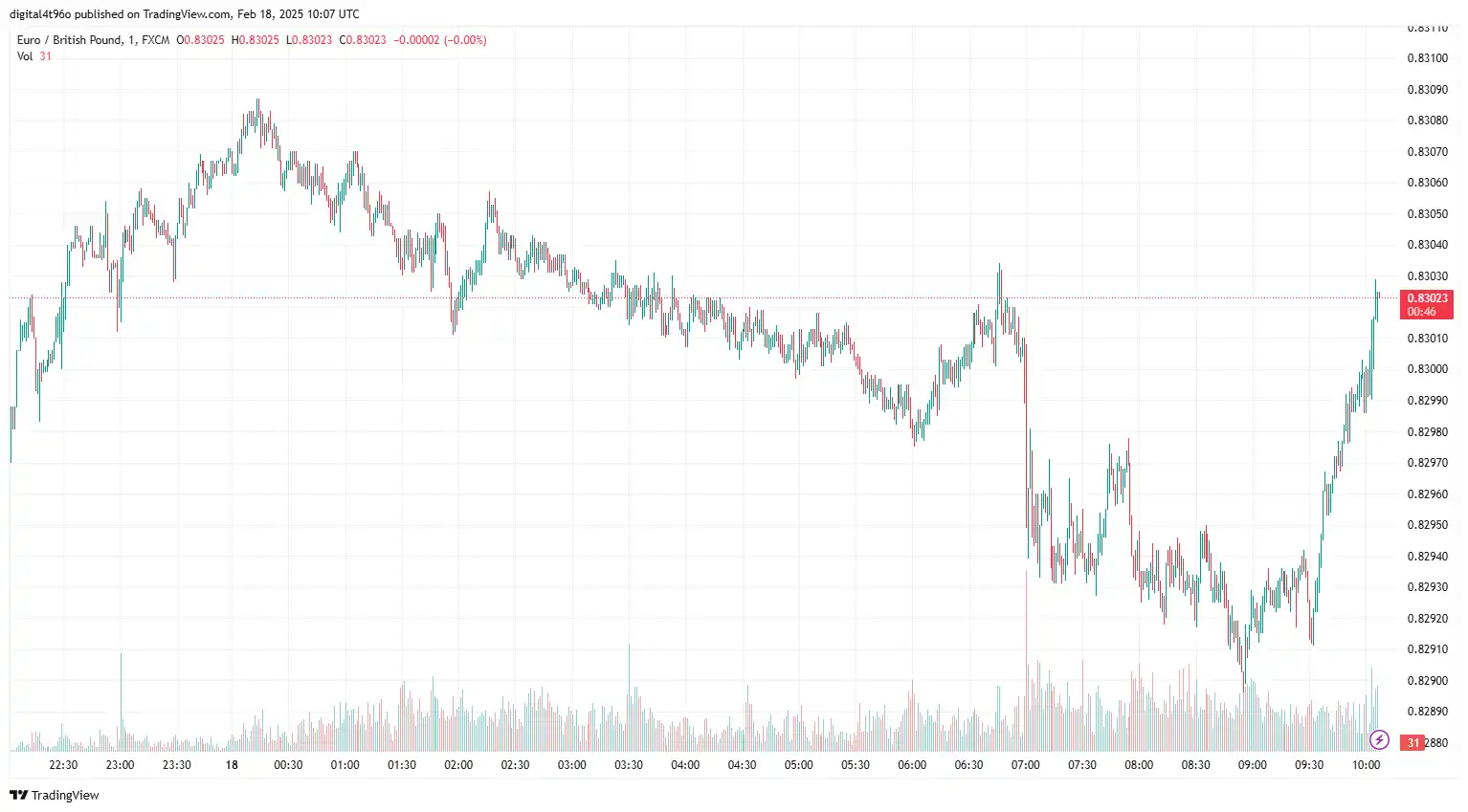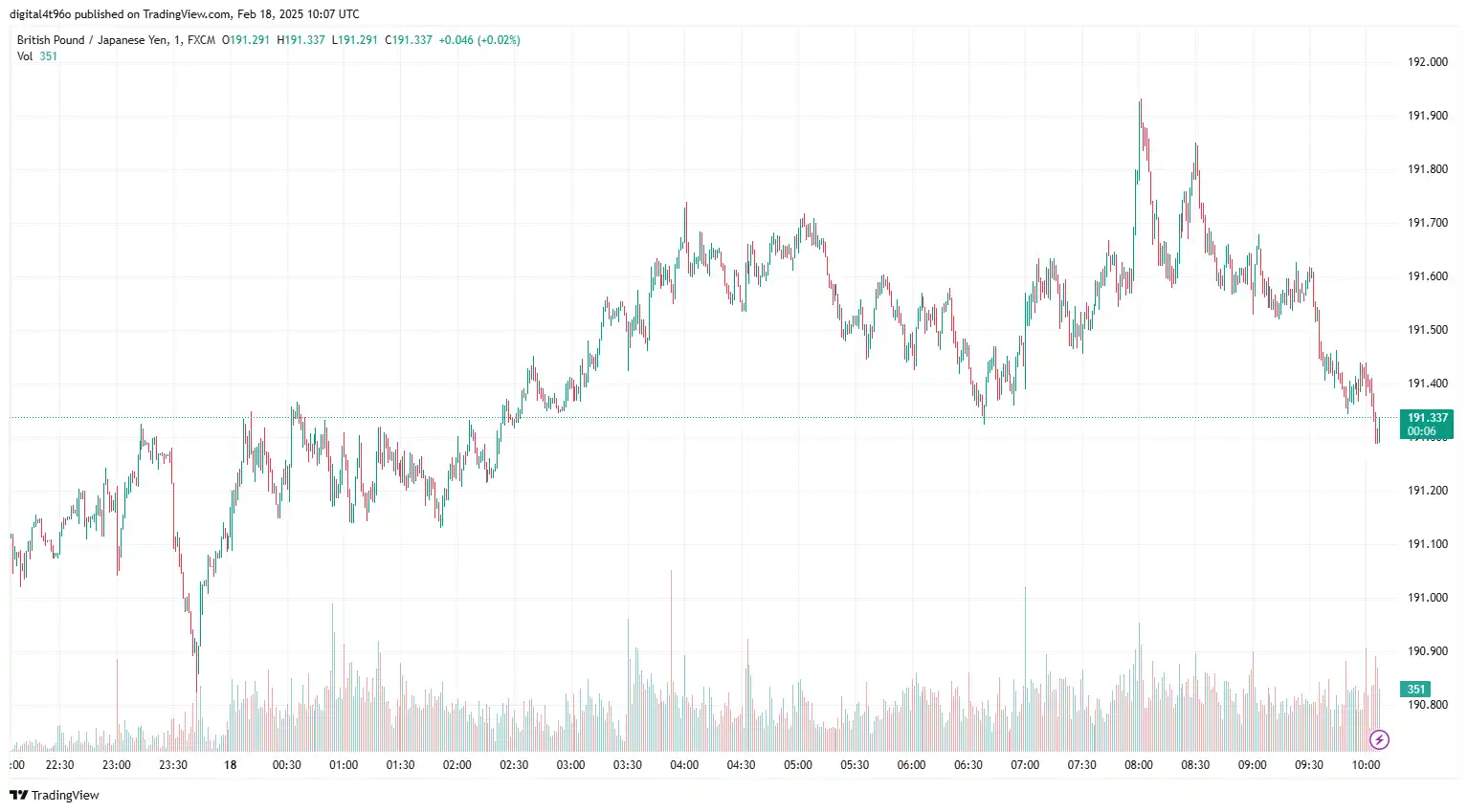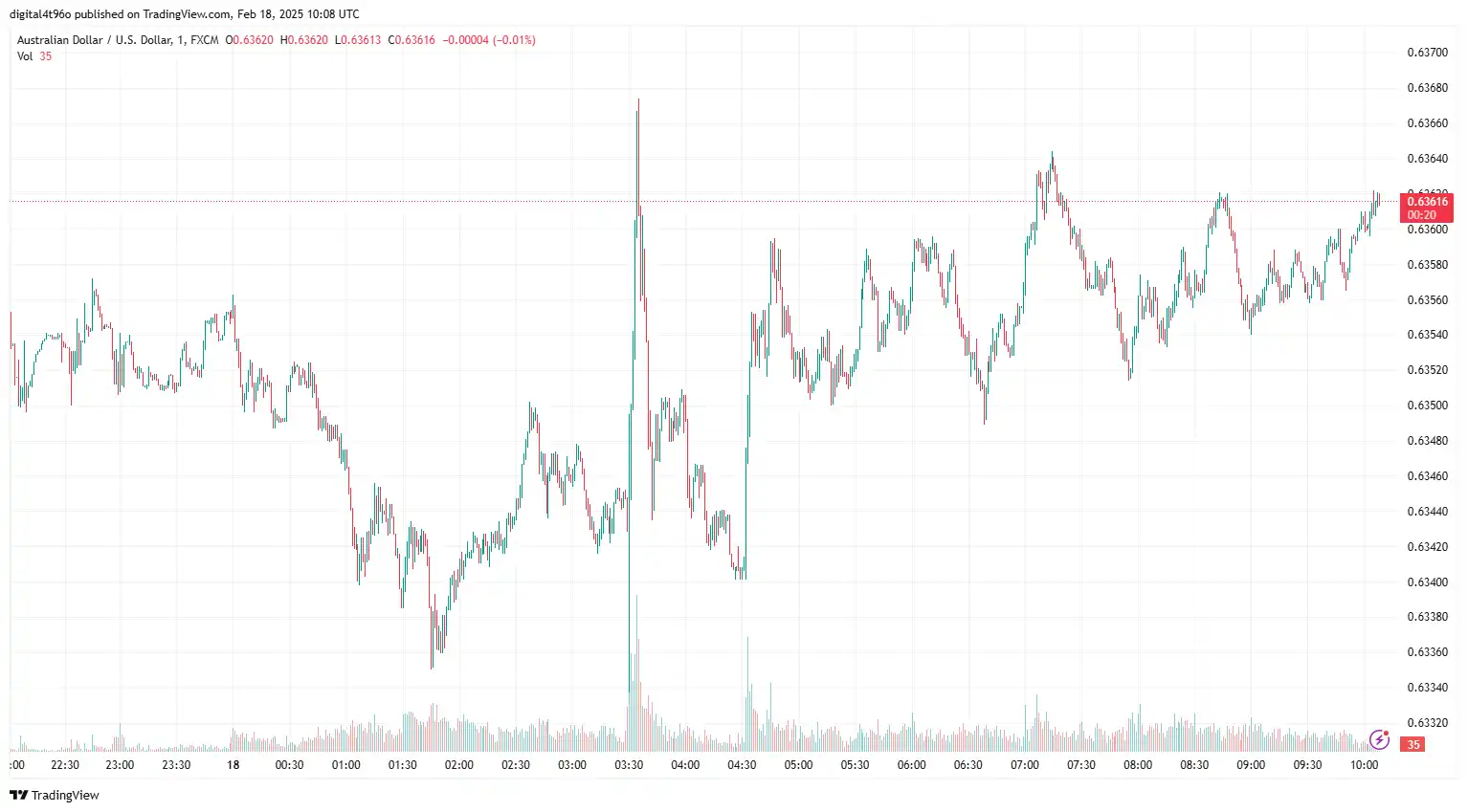EUR/GBP softens near 0.8293 following the release of the UK employment report. According to the UK Office for National Statistics, the ILO Unemployment Rate remained stable at 4.4% for the three months to December, beating expectations of a rise to 4.5%. The Claimant Count Change showed an increase of 22K in January, compared to a decrease of -15.1K in the previous month (revised from +0.7K), falling short of the forecasted 10K rise. Average Earnings data, an important indicator of wage growth, accelerated in the three months ending December. As expected, Average Earnings Excluding bonuses rose to 5.9%, up from 5.6% in the prior reading. Meanwhile, Average Earnings, Including bonuses, increased by 6%, surpassing the forecast of 5.9% and the previous reading of 5.6%.
On Monday, British Prime Minister Keir Starmer stated that any peace deal for Ukraine would require a "US backstop" to prevent Russia from launching further attacks on its neighbour. He also remarked, "The future of Ukraine is an existential issue for Europe. Europe must play its role." On the economic front, the UK economy grew 1.4% YoY in Q4 2024, exceeding expectations of 1.1% and accelerating from a revised 1.0% in the previous quarter. This marks the strongest GDP growth since Q4 2022. Yearly, GDP increased by 0.9%, up from 0.4% in 2023, driven by a 1.3% increase in the services sector. Investors are awaiting upcoming inflation figures for further insight into the Bank of England's (BoE) policy stance.
On the other hand, key European Central Bank (ECB) officials hinted at a dovish ECB policy for the remainder of the year, with potential rate cuts expected. According to recent data, the Eurozone's economy grew by 0.1% in Q4 2024, exceeding the initial reading of 0%. Eurozone GDP rose 0.9% YoY, matching market expectations. The Eurozone Employment Change for Q4 showed a 0.1% QoQ increase and a 0.6% rise YoY. The Eurozone's trade balance revealed a €15.5 billion surplus in goods trade with the rest of the world in December 2024, down from a €16.4 billion surplus in December 2023. In the Euro area, exports of goods to the rest of the world increased by 3.1% to €226.5 billion, while imports grew by 3.8% to €211.0 billion.
In today's session, investors will pay attention to BoE Governor Andrew Bailey's speech and Germany's ZEW Survey for February for a fresh direction for the EUR/GBP exchange rate.

GBP/JPY Rebounds on UK Labour Reports
GBP/JPY strengthens near 191.84, as positive UK employment data provides support for the pound. The ILO Unemployment Rate remained at 4.4%, contrary to expectations of an increase to 4.5%, despite business owners' concerns following Chancellor of the Exchequer Rachel Reeves' National Insurance (NI) hike. In the Autumn Budget, Reeves raised employers' contributions by 1.2%, bringing the total to 15%, effective in April. Along with strong employment figures, Average Earnings data for the three months ending December showed growth acceleration. Excluding bonuses, earnings rose by 5.9%, up from 5.6%. Including bonuses, earnings increased by 6%, exceeding the forecast of 5.9%. Claimant Count Change showed an increase of 22K in January, compared to a revised drop of 15.1K in December, missing the estimated 10K. Employment Change for December saw an increase of 107K, up from November's 35K.
The UK economy grew 1.4% YoY in Q4 2024, surpassing expectations of 1.1%, marking the fastest growth since Q4 2022. Annually, GDP expanded by 0.9%, up from 0.4% in 2023, driven by a 1.3% increase in the services sector. Strong wage growth could heighten inflation expectations, potentially compelling the BoE to maintain interest rates at 4.5%.
Positive market sentiment has also been bolstered by the postponement of US President Donald Trump's reciprocal tariffs, which has weighed on the Japanese Yen (JPY). Japan's economy grew by 0.7% in Q4 2024, up from a revised 0.4% in the previous quarter, marking the third consecutive quarter of growth. Yearly growth rose from a revised 1.7% in Q3 to 2.8%, reinforcing the BoJ's position on potential further rate hikes. On Monday, Japanese Chief Cabinet Secretary Yoshimasa Hayashi warned Japan that it could face challenges if businesses were pressured by President Trump's policies and stated that the government would respond cautiously to potential impacts. On Tuesday, BoJ Governor Kazuo Ueda commented, "We are aware of views we had not been clear enough in our policy guidance. Last summer's volatility was mainly caused by market concern over weak US jobs data and the US economic slowdown."
In the upcoming sessions, Japan's Trade data, BoE Governor Bailey's speech, jobs data, the latest inflation report, and Retail Sales data will all drive the GBP/JPY exchange rate.

EUR/USD Sinks Due to Stronger USD
EUR/USD declines to around 1.0457 as the US dollar strengthens due to improved market sentiment. On Monday, Federal Reserve Governor Michelle Bowman commented that rising asset prices may have slowed the Fed's recent progress on inflation. While Bowman expects inflation to decline, she cautioned that upside risks remain and emphasised the need for greater certainty before considering rate cuts. Fed Governor Christopher Waller acknowledged that while inflation has improved, the progress has been "excruciatingly" slow and stressed that the Fed must avoid letting policy uncertainty hinder data-driven decisions.
The euro faced additional pressure as ECB officials suggested further rate cuts, with market expectations growing that the ECB could lower its Deposit Facility rate three times this year. This dovish sentiment was reinforced by recent remarks from ECB policymaker Boris Vujčić. On the trade front, the shared currency was also weighed down by potential trade conflicts between the US and Europe, as US President Donald Trump unveiled plans to impose reciprocal tariffs on countries that levy duties on US imports.
The Eurozone's economy expanded by 0.1% in Q4 2024, exceeding the initial estimate of 0%, while year-over-year GDP rose by 0.9%, aligning with expectations. The Eurozone Employment Change for Q4 showed a 0.1% quarter-over-quarter rise and a 0.6% year-over-year increase. Meanwhile, the Eurozone trade balance revealed a €15.5 billion surplus in December 2024, down from €16.4 billion in December 2023. Exports rose by 3.1% to €226.5 billion, while imports grew by 3.8% to €211.0 billion.
A potential ceasefire in Ukraine could provide support for the euro, with reports suggesting that US President Trump and Russian President Putin are engaged in negotiations to resolve the conflict. US officials are scheduled to meet with their Russian counterparts in Saudi Arabia to discuss a potential peace deal.
In the absence of significant market-moving US data, broader market sentiment surrounding the ZEW Economic Sentiment index will influence the EUR/USD exchange rate.

AUD/USD Stabilises Following RBA Rate-Cut Decision
The Australian Dollar (AUD) edges higher against the greenback, trading at 0.6357, following the Reserve Bank of Australia's (RBA) policy decision. On Tuesday, the RBA lowered its Official Cash Rate (OCR) by 25 basis points to 4.10%, in line with market expectations, marking the first rate cut in four years. After the policy meeting, RBA Governor Michele Bullock acknowledged the impact of high interest rates but stated that it was too early to declare victory over inflation. She also highlighted the unexpectedly strong job market, clarifying that the expectation of further rate cuts is not assured. Recent fourth-quarter Consumer Price Index (CPI) data revealed that the headline inflation rate stands at 2.5% YoY, a decrease from 2.8%. Meanwhile, the trimmed-mean CPI has fallen to its lowest level in three years, at 3.2%. Australia's Consumer Inflation Expectations rose to 4.6% in February, up from 4.0% in January.
The US dollar (USD) traded cautiously on Monday as American markets were closed for Presidents' Day. Despite this, the USD ticked higher amid a risk-on market sentiment, although it remained under pressure due to weaker-than-expected US Retail Sales data for January. Retail sales fell by 0.9% in January, following a revised 0.7% increase in December, missing the forecasted 0.1% decline. On a YoY basis, retail sales rose by 4.2%. In addition to economic data, Trump's decision to propose a 25% tariff on steel and aluminium imports for all countries has effectively undermined trade agreements with significant US partners, including Australia. While Trump is considering Australia's request for an exemption from the steel tariffs, citing the trade deficit with the US, the market will closely monitor any developments in Trump's tariff policies.
In today's session, the Reserve Bank of Australia's (RBA) interest rate decision will shape market sentiment around the AUD/USD pair.

Stay Ahead in the Currency Game
Whether you're a daily FX trader or handle international transactions regularly, our 'Currency Pulse' newsletter delivers the news you need to make more informed decisions. Receive concise updates and in-depth insights directly in your LinkedIn feed.
Subscribe to 'Currency Pulse' now and never miss a beat in the currency markets!
Ready to act on today’s insights? Get a free quote or give us a call on: +44 (0)20 7740 0000 to connect with a dedicated portfolio manager for tailored support.
Important: This blog is for informational purposes only and should not be considered financial advice. Currency Solutions does not consider individual investment goals, financial circumstances, or specific requirements of readers. We do not endorse or recommend any particular financial strategies or products discussed. Currency Solutions provides this content as is, without any guarantees of completeness, accuracy, or timeliness.
Important Disclaimer: This blog is for informational purposes only and should not be considered financial advice. Currency Solutions does not take into account the investment objectives, financial situation, or specific needs of any individual readers. We do not endorse or recommend any specific financial strategies, products, or services mentioned in this content. All information is provided “as is” without any representations or warranties, express or implied, regarding its accuracy, completeness, or timeliness.




